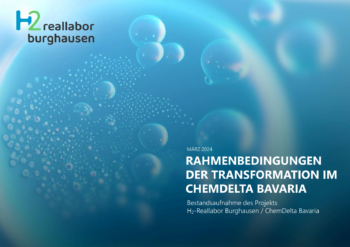The European balancing energy market
The balancing energy market (RAM) for Frequency Restoration Reserve with automatic activation (aFRR) and Frequency Restoration Reserve with manual activation (mFRR) was introduced in Germany in November 2020 and has since complemented the balancing power market. This was a step towards harmonizing the European balancing reserve based on the Electricity Balancing Guideline from 2017. This website article and the accompanying infographic provide a general overview of the emergence of the joint European balancing energy market. In some parts, this article is an update of the article on the balancing energy market in Germany. It sheds light on European cooperation from Germany’s point of view as a member state.

Development of a joint European balancing energy market
In 2017, the EU adopted the Electricity Balancing Guideline (EB-GL) to harmonize European balancing reserves. The aim of the EB-GL is to establish a pan-European market for balancing reserves, characterized by a uniform market design and free trade in balancing energy. It creates a binding framework for cross-border balancing of imbalances, enabling transmission system operators (TSOs) to procure balancing reserves more efficiently, reliably, and cost-effectively (see also https://www.entsoe.eu/network_codes/eb/ ). According to the EB-GL, a European transnational balancing energy market for aFRR and mFRR is to be introduced to harmonize the balancing reserve. These markets have been implemented via the two implementation projects PICASSO and MARI.
PICASSO stands for Platform for the International Coordination of Automated Frequency Restoration and Stable System Operation. It is the implementation project for developing a European aFRR platform, launched in 2017. 30 TSOs are involved in PICASSO, 26 active members and 4 observers (shown in the infographic). On 1st April 2022, PICASSO had its go-live with CEPS, the TSO of the Czech Republic, as the first operating member (before the deadline). On 22nd June 2022, the first energy exchange took place after the accession of APG (Austria) and the German TSOs. The following TSOs are members:
- Austria (APG),
- Belgium (ELIA),
- Bulgaria (ESO),
- Croatia (HOPS),
- Czech Republic (ČEPS),
- Denmark (Energinet),
- Deutschland (50Hertz, TransnetBW, TenneT DE, amprion),
- Finland (Fingrid),
- France (RTE),
- Greece (IPTO/ADMIE),
- Hungary (MAVIR),
- Italy (Terna),
- Luxembourg (Creos).
- Netherlands (TenneT NL),
- Norway (Statnett),
- Poland (PSE),
- Portugal (REN),
- Romania (Transelectrica),
- Slovakia (SEPS),
- Slovenia (ELES),
- Spain (REE),
- Sweden (Svenska Kraftnät),
- Switzerland (Swissgrid) and
Current observers are the ENTSO-E, Estonia (Elering),Latvia (AST), Lithuania (Litgrid) and North Macedonia (MEPSO).
MARI stands for Manually Activated Reserves Initiative and is the implementation project for developing a European mFRR platform. Currently (June 2023), 32 TSOs are involved in MARI (shown in the infographic). The cooperation with 19 TSOs started in 2017. On 15th September 2022, MARI had its technical go-live, with the first 5 TSOs (CEPS and German TSOs) joining on 5th October 2022. Current members are:
- Austria (APG),
- Belgium (ELIA),
- Bulgaria (ESO),
- Croatia (HOPS),
- Czech Republic (ČEPS),
- Denmark (Energinet),
- Deutschland (50Hertz Transmission, Amprion, TenneT DE, TransnetBW),
- Estonia (Elering),
- Finland (Fingrid),
- France (RTE),
- Greece (IPTO/ADMIE),
- Hungary (MAVIR),
- Italy (Terna),
- Latvia (AST),
- Lithuania (Litgrid),
- Luxembourg (Creos).
- Netherlands (TenneT NL),
- Norway (Statnett),
- Poland (PSE),
- Portugal (REN),
- Romania (Transelectrica),
- Slovakia (SEPS),
- Slovenia (ELES),
- Spain (REE),
- Sweden (Svenska Kraftnät),
- Switzerland (Swissgrid) and
Current observers are the ENTSO-E, Ireland (EirGrid), North Macedonia (MEPSO) and Northern Ireland (SONI)
For the go-live of the two platforms, the target market design for the procurement of balancing energy was introduced in all participating countries. This includes, among other things, quarter-hourly time slices and the pay-as-cleared remuneration system (marginal pricing). In addition, the price cap for the next four years has been set at 15,000 €/MWh based on an ACER study. According to this study, the price cap will be increased to 22,940 €/MWh for 2024-2026. This is because the study found that 22,940 €/MWh is the maximum willingness-to-pay of the TSOs and therefore should not be exceeded. In 2023 and 2024, the connection of further members is planned so that from the 2nd quarter of 2024, a large part of the EU states will have already joined the two platforms. Many TSOs had asked for exemptions regarding their entry date to ensure a technically smooth connection. France’s TSOs RTE have been granted a derogation until 24th July 2024. However, RTE has already clarified that at least another year will be required to connect RTE to the MARI platform to ensure the operational security of the French electricity grid.
Excursus Switzerland
The Swiss TSO Swissgrid has set up the balancing energy platforms together with the members of the ENTSO-E and meets all the technical requirements for a connection. However, Switzerland is not allowed to participate in the international balancing energy market. The reason for this is Articles 1.6 and 1.7 of the EB GL.
It regulates Switzerland’s requirements for accession, which the EU Commission does not currently consider to be met. Specifically, it calls for Switzerland to transpose essential provisions of EU law for the electricity market into Swiss law and an intergovernmental agreement on cooperation between the Union and Switzerland in the electricity sector. Switzerland can also be granted a connection to the platforms if their exclusion could lead to unplanned physical flows of services through Switzerland that jeopardize the region’s system security. However, the EU does not see any risk for that. In October 2022, Swissgrid clarified that they will continue to guarantee technical compatibility for the cross-border exchange of balancing energy. Swissgrid has changed its billing model to marginal pricing according to European guidelines to ensure this. At the same time, 25 Swiss energy suppliers have complained to the supervisory authority Elcom about price increases on the part of Swissgrid.
According to the complainants, these are said to have been caused by implementing the billing model for PICASSO. Swissgrid has stated that the changeover to the PICASSO market design is a logical consequence of Switzerland’s central location in the European interconnected grid and that Swissgrid will not return to the original billing model. It remains to be seen whether the EU and Switzerland will find a solution and whether Switzerland will be allowed to participate in the pan-European balancing energy market.
External website articles
- News von Regelleistung.net
- Electricity Balancing Guideline (GL EB) 11/2017
- Einführung eines Regelarbeitsmarktes, BNetzA 10/2019
- ENTSO-E über die Electricity Balancing Guidline 03/2021
- ACER Dokument zu Preisobergrenze 02/2022
- „Update on Balancing Platforms“ der ÜNB 03/2023
- PICASSO
- PICASSO Roadmap 04/2023
- MARI
- MARI Roadmap 04/2023
- Exkurs Schweiz:
Further FfE articles on balancing services
- Deutscher Regelarbeitsmarkt – Infografik
- Einführung des Mischpreisverfahrens im Regelleistungsmarkt führt deutlich zu steigenden Leistungspreisen und sinkenden Arbeitspreisen (01/2019)
- Primärregelleistungspreise im neuen Marktdesign – In welche Richtung werden sich die PRL-Preise zukünftig bewegen? (09/2021)
- Neues Ausschreibungsverfahren für Primärregelleistung seit dem 1. Juli 2019 – eine erste Zwischenbilanz (08/2019)
- Preisprognose Primärregelleistung (12/2018)


